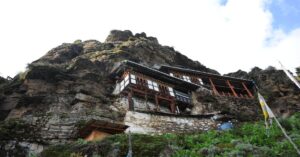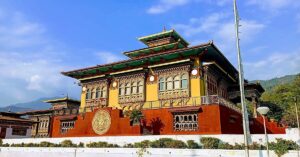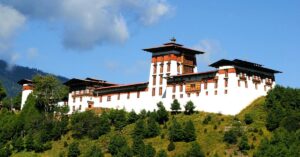Changangkha Lhakhang, also known as Phagpa Ranjung Tsuglakha, is a temple dedicated to Avalokiteshvara. It was founded by Nyima, one of the sons of Phajo Drugom Zhigpo, in the 13th century. The temple complex is perched on the tip of a ridge that extends from the eastern hills toward central Thimphu.
The principal deity of Changangkha Lhakhang is Kasung Geynyen Domtsangpa. Parents visit this temple with young children to seek blessings from Tamdrin, the birth deity and guardian of children born in Thimphu.
Changangkha Lhakhang, therefore, holds a special place in the hearts of locals and visitors alike, making it a must-visit destination.
How to Reach Changangkha Lhakhang
Changangkha Lhakhang is situated on a ridge southeast of Motithang, approximately 1 kilometer above the heart of Thimphu. It can be reached within 10 minutes by car or in 30 minutes by an uphill walk from the town. The temple opens daily from early morning until 6 pm, and remains open year-round. The entry fee to Changangkha Lhakhang is Nu 500.
History of Changangkha Lhakhang
Nyima Chog built Changangkha Lhakhang in the 13th century.
According to the history of Changangkha Lhakhang, the sacred site was blessed by Guru Rinpoche in the 7th century. Centuries later, in the 12th century, Phajo Drugom Zhigpo meditated here.
In the 13th century, Nyima Chog, one of Phajo Drugom Zhigpo’s sons, witnessed Guru Rinpoche’s celestial horse, “Changshey”. Interpreting the vision as an auspicious sign, he built a temple. The Lhakhang was named Phagpa Ranjung Tsuglakha, meaning the temple of self-manifested Avalokiteshvara.
Over the centuries, many great Buddhist masters, including Lama Drukpa Kunley, Ngawang Chogyal, and Zhabdrung Ngawang Namgyal, visited and blessed the temple. The temple underwent major renovations in 1998 and further restorations in 2012, followed by the construction of a monastic hostel in 2014.
Significance of Changangkha Lhakhang
What is the significance of Changangkha Lhakhang? Changangkha Lhakhang is a key spiritual site for the people of Thimphu, especially for newborns and children. It serves as a place for naming ceremonies and blessings from the protector deity. The temple also holds historical importance, having been blessed by Guru Rinpoche, meditated on by Phajo Drugom Zhigpo, and established by Nyima.
Description of Changangkha Lhakhang
The main statue of Changangkha Lhakhang is a “self-arisen” Mahakarunika form of Avalokiteśvara (Chenrizig Chuchi Zhel).
Changangkha temple is built along the descending natural ridgeline. At the top is the main Lhakhang, with a golden roof facing east toward Thimphu. The main statue of Changangkha Lhakhang is a huge bronze Avalokiteshvara in his Mahakarunika form, with eleven faces and eleven arms. Some believe the statue miraculously “self-arisen,” while others claim it was sculpted by a skilled Newar artisan during the temple’s construction.
Other sacred relics include Shakyamuni Buddha, Khandro Yeshe Tsogyal, founder Nyima Chog, Manjushri, Guru Rinpoche, and Chagna Dorji, all of whom are said to have been consecrated during Nyima Chog’s time. The temple also houses Bumpo Ti 16, a compilation of sacred texts authored by Nyima Chog.
Surrounding the Lhakhang on three sides is a fortified wall that contains prayer wheels and slate carvings depicting Buddhas and Kagyu lineage masters. A circumambulation path runs along this wall, where devotees perform kora (ritual walking) in meditation and prayers.
Goenkhang
Facing the main temple to the west, across a small courtyard, is the Goenkhang, a black, fortress-like shrine dedicated to the protective deities. Built of stone, it is the abode of Kasung Geynyen Domtsangpa, a protective deity of Changangkha Lhakhang, Pal Yeshe Gonpo (Mahakala), and Palden Lhamo, the guardian deities of Bhutan. However, entrance to this temple is allowed only to Bhutanese men.
A small shrine dedicated to a tshomen is outside Goenkhang, along with the monk quarters.
Below the Changangkha Monastery, towards the right side of the Norling building, below the road, is Tamdrin Drupchu. This holy spring is said to have originated underneath the foot of Tamdrin. There are two water sources: one blessed by Zhabdrung Ngawang Namgyal and the other by Drukpa Kunley’s Drupchu, a little further.
A little up above the road is the dwelling place of local deity Domsap, and toward the right is Ap Sang Sang and Aum Dung Dung’s Drupchhu and Drupkhang. However, the holy water of Phajo, located to the left of Changangkha Lhakhang, has been defiled for a long time and is now dried up.
Naming Ceremony for Newborn
In Bhutanese tradition, parents often seek a lama’s blessings and a name for their baby rather than choosing one themselves. Changangkha Lhakhang is one of the temples for this ritual. The presiding lama bestows names such as Tandin or Sonam, and blesses the child with a phurba (ritual dagger). He then gives a sacred thread for life-long protection and good fortune. While from Chimi Lhakhang, the temple of fertility, the babies are named Chimi or Kunley.
Changangkha Lhakhang Festival
Dues Choe Bumde is an annual ritual held from the 12th to the 14th day of the ninth Bhutanese lunar month. The event honors “Domsap”, the guardian deity of Changangkha Lhakhang, with rituals, masked dances, and traditional Bhutanese performances.
During the ritual, the lay monks (gomchens) from their meditation center at Gogona in Phobjikha Valley recite the entire Kangyur (a large ancient Buddhist canon) of over 100 volumes, written in gold ink.
Best Time to Visit Changangkha Lhakhang
You can visit Changangkha Lhakhang anytime. It is open year-round and near Thimphu’s city center. The best time, however, would be during the DueChoe Bumdey festival. You can visit the major pilgrimage sites of Thimphu with the Bhutan Pilgrimage Package.
Other Sacred Sites to Explore in Thimphu
Buddha Dordenma: It is a massive golden statue of Buddha Shakyamuni overlooking the Thimphu valley. The site also houses thousands of smaller Buddha statues and a meditation hall.
Tashichho Dzong: It is a fortress that houses the king’s throne room, government offices, and the central monastic body. Known as the “Fortress of the Glorious Religion,” it blends religious and administrative functions with stunning Bhutanese architecture.
Pangri Zampa Monastery: It is one of Bhutan’s oldest monasteries, founded in the 16th century by Ngawang Chogyal. The monastery now functions as Bhutan’s Royal College of Astrology, responsible for determining dates for important national events.
Dechenphu Lhakhang: It is a monastery dedicated to Geynyen Jagpa Melen, a powerful protective deity, located at the northern end of the Thimphu Valley in Bhutan. The Temple was constructed in the 12th century by Dampa, the son of Phajo Drugom Zhigpo.
Cheri Monastery: It is the first monastery established in Bhutan by Zhabdrung Ngawang Namgyel in 1620.
Tango Monastery: The Tango Choying Dzong was founded in the 13th century by Phajo Drugom Zhigpo. The monastery is perched on a forested hillside near Cheri Mountain.
Thuji Dra Monastery: It is one of the four cliffs prophesied by Guru Rinpoche to Phajo Drugom Zhigpo. The Thujidra Temple is located at an altitude of nearly 4,000 meters, where Phajo saw in a vision Phagpa Thujechenpo while meditating here.
Enjoyed reading this blog?




